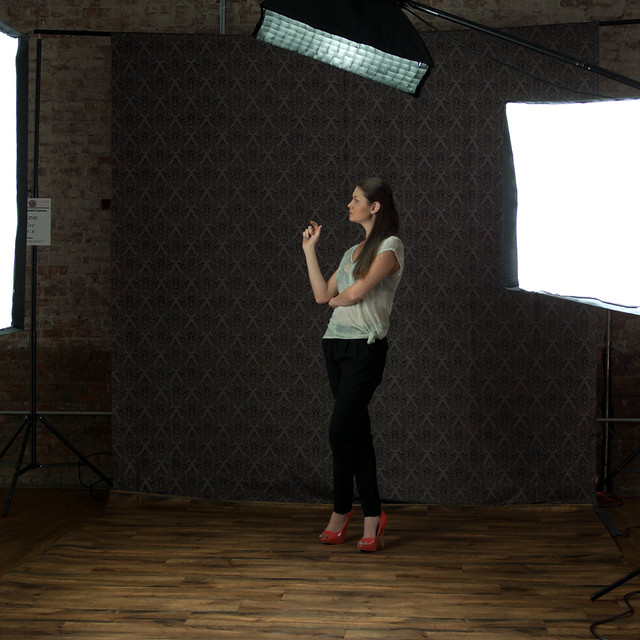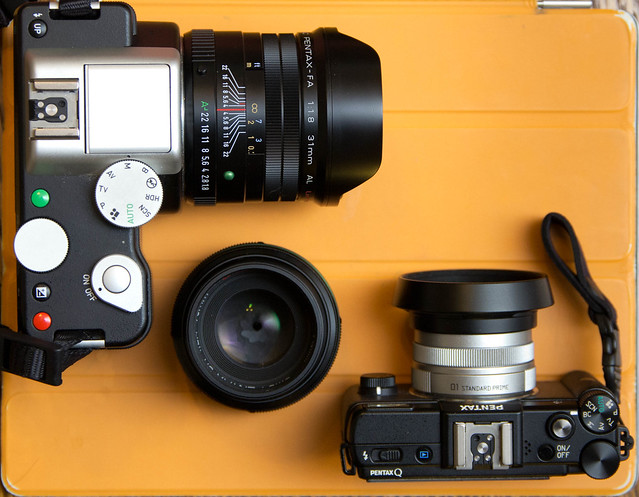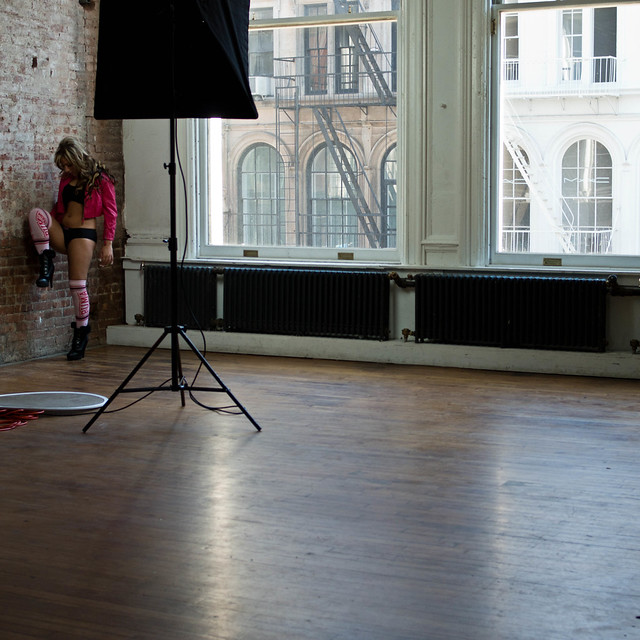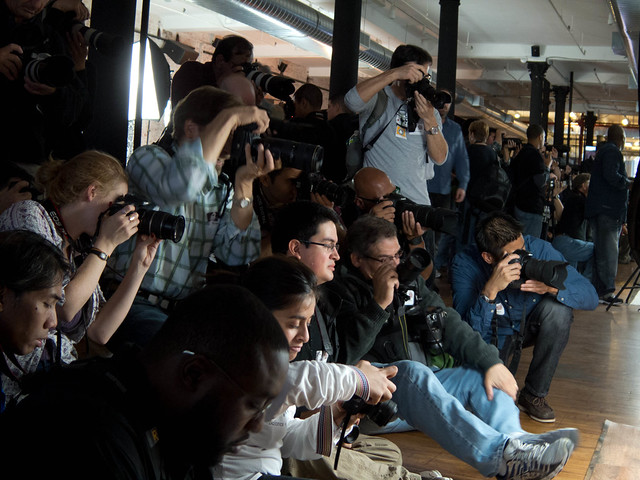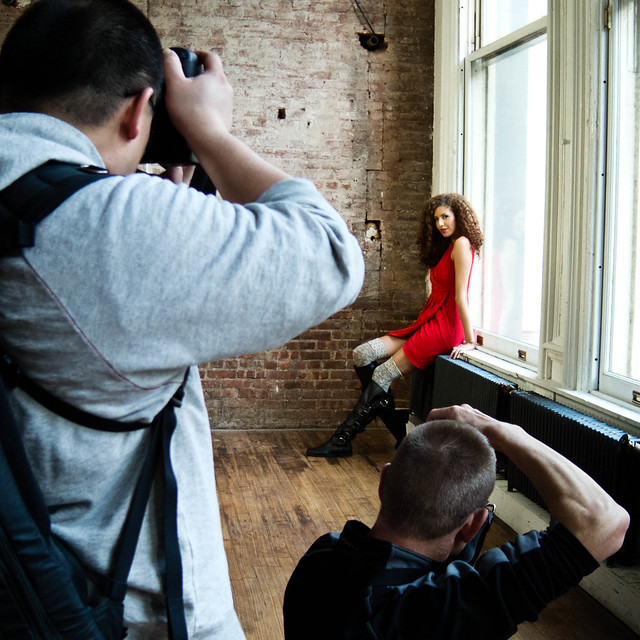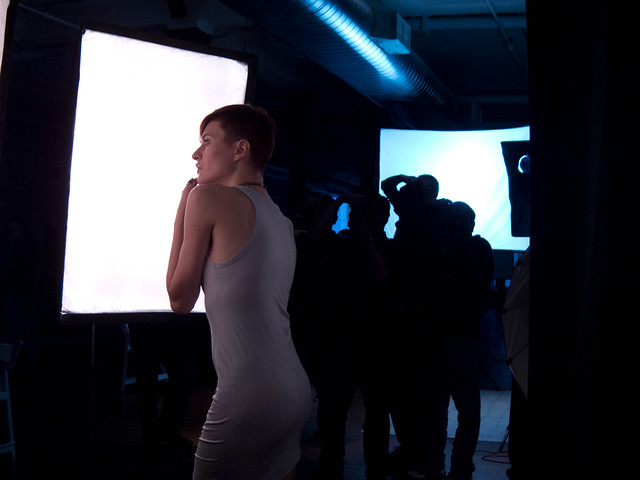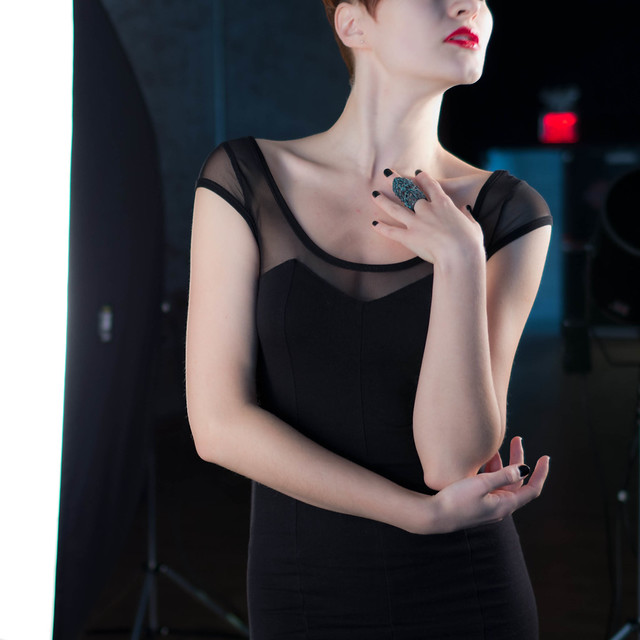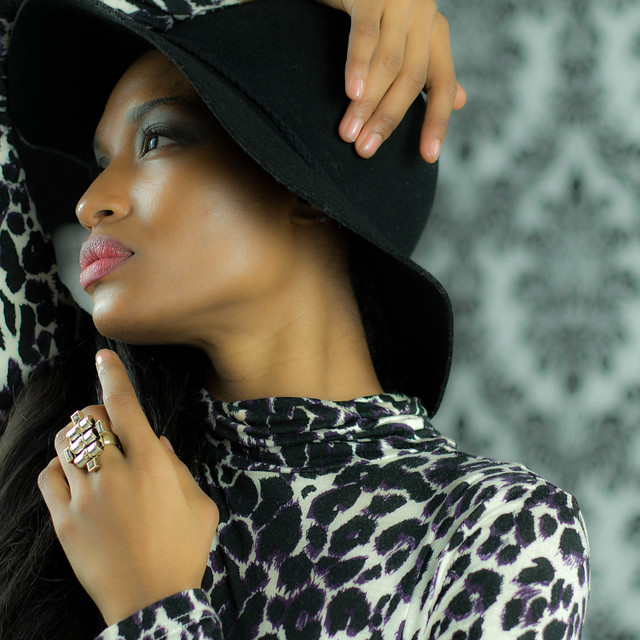Followers of this blog (both of you) might surmise that I went to the American Photo Model Shoot in NYC, courtesy of friend and fellow photographer Stephen Harris. Fellow photog Don Hoffler joined as well, and after a light breakfast, we got to shooting in a cool, spacious former warehouse space in SOHO. Hardwood floors, brick walls, tall ceilings, very 19th century industrial and very cool. American Photo, Sigma, and Unique Photo were all there, along with pro photographers Kevin Ames and Lindsay Adler who spent the day generally being really cordial and helpful, walking the floor, manning the Sigma SD1 station, and giving informative and inspiring speeches. I always enjoy hearing other photogs talk about their process and how they arrive at photos. There’s always something to learn.
In the days leading up to the event, I had pondered what gear to bring. Instinctively, I thought that the Pentax K-5 with the DA* 50-135 F2.8 would do the trick quite nicely, the added grip facilitating portrait shooting. The DA* 50-135 is a wonderful zoom with great character. AF is a touch slow, but you live with your choices, right? The initial plan was to bring the K-01 as well as backup of sorts, with the new-to-me FA31 F1.8 Limited mounted, and maybe the DA70 F2.4 in the bag as backup. I’d used the K-01 for evening indoor events in the past and had been sorely disappointed with the AF, so I wasn’t holding much hope that it could do the trick.
But sometime during the week my thinking changed. “F1.8,” I kept telling myself, “…that new-to-you FA 31 needs a proper workout. Besides, this isn’t a paid gig or anything. You’re just dipping your toes into a new genre that you haven’t done before. Plus, you really like traveling light, and the K-01 IQ is more than good enough.” To make a long story short, I convinced myself, and the night before, packed the K-01 with FA31 mounted, the DA70 and DA21mm F3.2, and the Pentax Q, because it takes up so little space it’s hard to leave behind. I had updated the K-01 firmware recently, which around the house at least had improved AF considerably. This was going to a trial by fire for sure.
A couple other things swayed me towards the K-01. One, I actually enjoy composing and shooting with the rear screen. I grew up on optical viewfinders, but I’m coming to the realization that lifting a camera to the eye separates you from the environment that you are in. That’s good in some circumstances, but I don’t find that necessary, and I thought that there might be some benefit to actually being able to talk to the models. Two, I’m completely smitten by shooting square these days and I wanted to see the square as I shot. You can’t do that with the optical viewfinder of the K-5 AFAIK. I never really considered the other cameras in the stable (Nikon V1 and Panasonic GH2) as I didn’t have the right glass for either. So it was the K-01 and a fistful of primes in a small Timbuktu Snoop Messenger. And the Q. All small. All good.
I imagined that when I got there I’d be surrounded by a sea of Nikons and Canons with big zoom glass mounted, and I wasn’t wrong. I’m guessing that there was nearly 200 photogs there and I could count on one hand the number of photogs not using a dSLR. I saw an Olympus OM-D EM-5 mounted on a monopod, and I think I spied a point-and-shoot at some point. I even saw a fellow shooting medium format film with a waist level viewfinder. And me with the K-01. That’s about it. I saw a red Pentax K-x, the only one that I’d ever seen in the wild besides my wife’s. So that was cool too.
The first thing about shooting with primes instead of zooms is that you’ve got to use your feet. There were six plus shooting stations, each lit with constant light (they recommended shooting at ISO800) and with the model against a backdrop. At any moment, there were usually a dozen or so fellow photos shooting the model against the backdrop. Nearly all had zooms of course, so they could simply pick a spot, zoom, and click click click. I started with the FA31 and at first really struggled to get a good shooting spot. I worked my way in at a couple of the stations, and fired away, only to wonder if I was getting the focus right. Some of the backgrounds had patterns on them, and as I shot, I wondered whether the camera was focusing on the subject of the background. You know how it goes – you shoot, chimp, zoom in and then ask yourself, “Is the subject soft? Is it just the rear screen? Is it the JPG preview? Will it be all good once I get home?” I kept shooting, even though I had a sneaking suspicion. Not helping the situation was the fact that the FA31 is new to me, so I’m a bit infatuated with the idea of shooting it wide open at the moment. I paid for F1.8 after all LOL. When I got home my fears were realized. Yes, a good number of the shots with the FA31 were out of focus. More than I wanted. But I don’t blame the camera or the lens. I could have and should have stopped down to have more working DOF. I should have brought my iPad to check AF early. And I should have just switched to MF and relied upon focus peaking. Lesson learned.
It didn’t take long to tire of the scrum that was happening at each shooting station. Everyone was nice and polite about it – no starlet hounding paparazzi here – but I figured that they were all shooting from basically the same spot using basically the same kind of gear and thus were all going to get the same kind of picture. No doubt some of it would be very good, but I was interested in finding something else. So I stepped aside and looked for other angles. I shot low, I shot from just behind the key light, I shot right into the key light. I just shot. I mounted the DA70 and shot some more, working to fill the square frame with interesting, dynamic compositions. I snuck to the side of the SD1 shooting station (with what looked like tungsten balanced lighting) and shot Olga from different angles than the lighting was set up for. I played. And I had a good time.
We had some empanadas for lunch, and spent some time walking SOHO for some street shots (look for them in upcoming posts), and then went back and shot some more. I took about 600 photos of the models in all, and that was shooting RAW and at the K-01’s miserly one frame per second. As I walked around, I could hear the soft bursts of five, six, and seven frames per second and more. I suspect that others are digging through many hundreds more photos than me. Did I want more FPS? Not really, as there was a clear rhythm to the shooting; the model would strike a pose, hold it for five seconds, and then strike another pose. Within each sequence, I could easily compose and shoot one or two shots. I’d miss some poses if I was chimping, but that’s ok, since the next pose was right around the corner. Once in a while a model would strike a post that I really liked and I’d rush to compose, focus, and shoot; those are probably the only times where I wish I had faster AF or more FPS. Otherwise, I don’t think the K-5 would have given me any distinct advantage over the K-01.
One thing I do miss is the ability to chimp at a particular zoom level. The dual wheels of the K-5 permits that; zoom in/out with one wheel, scroll with the other. This works well when you are checking focus on a sequence of shots, and this process was much more labored on the K-01.
Speaking of AF, I stumbled upon one neat thing about shooting square – I could set the AF point in the upper left third of the frame, and if I wanted to shift the AF point to the upper right third of the frame all I had to do was rotate the camera 90 degrees clockwise. BAM!, AF point moved in the blink of an eye, instead of tap-tap-tapping the right button. The only thing better than this would be a touch screen, like the one on the Panasonic GH2. I also played with face-detect AF and it seemed to work pretty well, but only when the model is facing you and both eyes are visible. It didn’t work well for profiles and odd angles as well, so I didn’t use it all that much.
All in all it was a really good day. It was a chance to try something new, photograph a lot of enthusiastic models, and hang out with other photographers. At the end of the day you could tell that everyone had been working hard on their craft as the loft space had the distinct smell of a gym locker. But that’s ok, all in a day’s play, right?
Read more about the Pentax K-01 in the Pentax K-01 Compendium.

